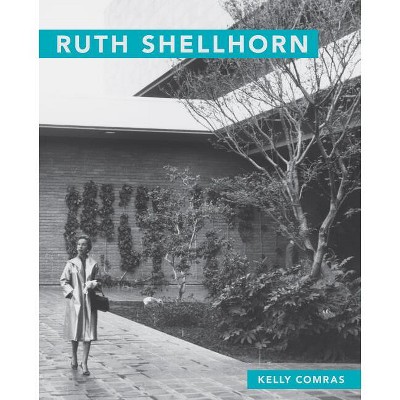About this item
Highlights
- Mary Crovatt Hambidge (1885-1973) was an aspiring actress and a professional whistler on Broadway when she met Canadian-born Jay Hambidge (1867-1924), an artist, illustrator, and scholar.
- About the Author: VIRGINIA GARDNER TROY is a scholar of twentieth-century art and design and a professor of art history at Berry College.
- 176 Pages
- Biography + Autobiography, Artists, Architects, Photographers
Description
About the Book
"Mary Crovatt Hambidge (1885-1973) was an aspiring actress and a professional whistler on Broadway when she met Canadian-born Jay Hambidge (1867-1924), an artist, illustrator, and scholar. Their relationship would prove to be both a romantic and an artistic partnership. Jay Hambidge formulated his own artistic concept, known as Dynamic Symmetry, which stipulated that the compositional rules found in nature's symmetry should be applied to the creation of art. Mary Hambidge pioneered new techniques of weaving and dyeing fabric that merged Greek methods with Appalachian weaving and spinning traditions. The Hambidge Center for Creative Arts and Sciences, formed during the mid-1930s, provides an artists' community situated on six hundred rural acres in the north Georgia mountains where hundreds of visual artists, writers, potters, composers, dancers, and other artists have pursued their crafts. Dynamic Design details Jay Hambidge and Mary Crovatt Hambidge's cross-cultural and cross-historical explorations and examines their lasting contributions to twentieth-century art and cultural history. Virginia Gardner Troy illustrates how Jay and Mary were important independently and collectively, providing a wider understanding of their lives within the larger context of late nineteenth- and early twentieth-century art and design. They were from two different worlds, nearly a generation apart in age, and only together for ten years, but their lives intertwined at a pivotal moment in their development. They shared parallel goals to establish a place where they could integrate the arts and crafts around the principles of Dynamic Symmetry. Troy explores how this dynamic duo's ideas and artistic expressions have resonated with admirers throughout the decades and reflect the trends and complexities of American culture through various waves of cosmopolitanism, utopianism, nationalism, and isolationism. The Hambidges' prolific partnership and forward-thinking vision continue to aid and inspire generations of aspiring artists and artisans"--Book Synopsis
Mary Crovatt Hambidge (1885-1973) was an aspiring actress and a professional whistler on Broadway when she met Canadian-born Jay Hambidge (1867-1924), an artist, illustrator, and scholar. Their relationship would prove to be both a romantic and an artistic partnership. Jay Hambidge formulated his own artistic concept, known as Dynamic Symmetry, which stipulated that the compositional rules found in nature's symmetry should be applied to the creation of art. Mary Hambidge pioneered new techniques of weaving and dyeing fabric that merged Greek methods with Appalachian weaving and spinning traditions. The Hambidge Center for Creative Arts and Sciences, formed during the mid-1930s, provides an artists' community situated on six hundred rural acres in the north Georgia mountains where hundreds of visual artists, writers, potters, composers, dancers, and other artists have pursued their crafts.
Dynamic Design details Jay Hambidge and Mary Crovatt Hambidge's cross-cultural and cross-historical explorations and examines their lasting contributions to twentieth-century art and cultural history. Virginia Gardner Troy illustrates how Jay and Mary were important independently and collectively, providing a wider understanding of their lives within the larger context of late nineteenth- and early twentieth-century art and design. They were from two different worlds, nearly a generation apart in age, and only together for ten years, but their lives intertwined at a pivotal moment in their development. They shared parallel goals to establish a place where they could integrate the arts and crafts around the principles of Dynamic Symmetry. Troy explores how this dynamic duo's ideas and artistic expressions have resonated with admirers throughout the decades and reflect the trends and complexities of American culture through various waves of cosmopolitanism, utopianism, nationalism, and isolationism. The Hambidges' prolific partnership and forward-thinking vision continue to aid and inspire generations of aspiring artists and artisans.Review Quotes
The activities of Jay Hambidge and Mary Crovatt Hambidge themselves are so diverse that Dynamic Design will draw a diverse array of scholarly interest. By treating Jay and Mary as a pair, Virginia Gardner Troy adds breadth to our understanding of modern design in the twentieth century.--Marie Frank "author of Denman Ross and American Design Theory"
Virginia Gardner Troy's Dynamic Design weaves a fascinating tale of two visionaries whose creative energy inspires us still. With beautiful illustrations and masterful documentation, Troy captures the complexity and intensity of the lives of Jay Hambidge and founder of the Hambidge Center, Mary Crovatt Hambidge, whose legacy we are proud to have built upon and carried with new vision and inspiration into the twenty-first century.--Jamie Badoud, executive director, Hambidge Center for the Creative Arts and Sciences
Both Mary Crovatt Hambidge and Jay Hambidge had major influences on art history, visual arts, mountain crafts, and artist communities. Their combined influence and story deserve to be told.--Rosemary McGee, director emerita of the Stuart A. Rose Manuscript, Archives, and Rare Book Library at Emory University
About the Author
VIRGINIA GARDNER TROY is a scholar of twentieth-century art and design and a professor of art history at Berry College. She is the author of two books, The Modernist Textile: Europe and America, 1890-1940 and Anni Albers and Ancient American Textiles: From Bauhaus to Black Mountain. She has also published articles on mid-twentieth-century weaving, Appalachian weaving, Marie Cuttoli, and many other subjects. She lives in Rome, Georgia.Shipping details
Return details
Trending Non-Fiction












